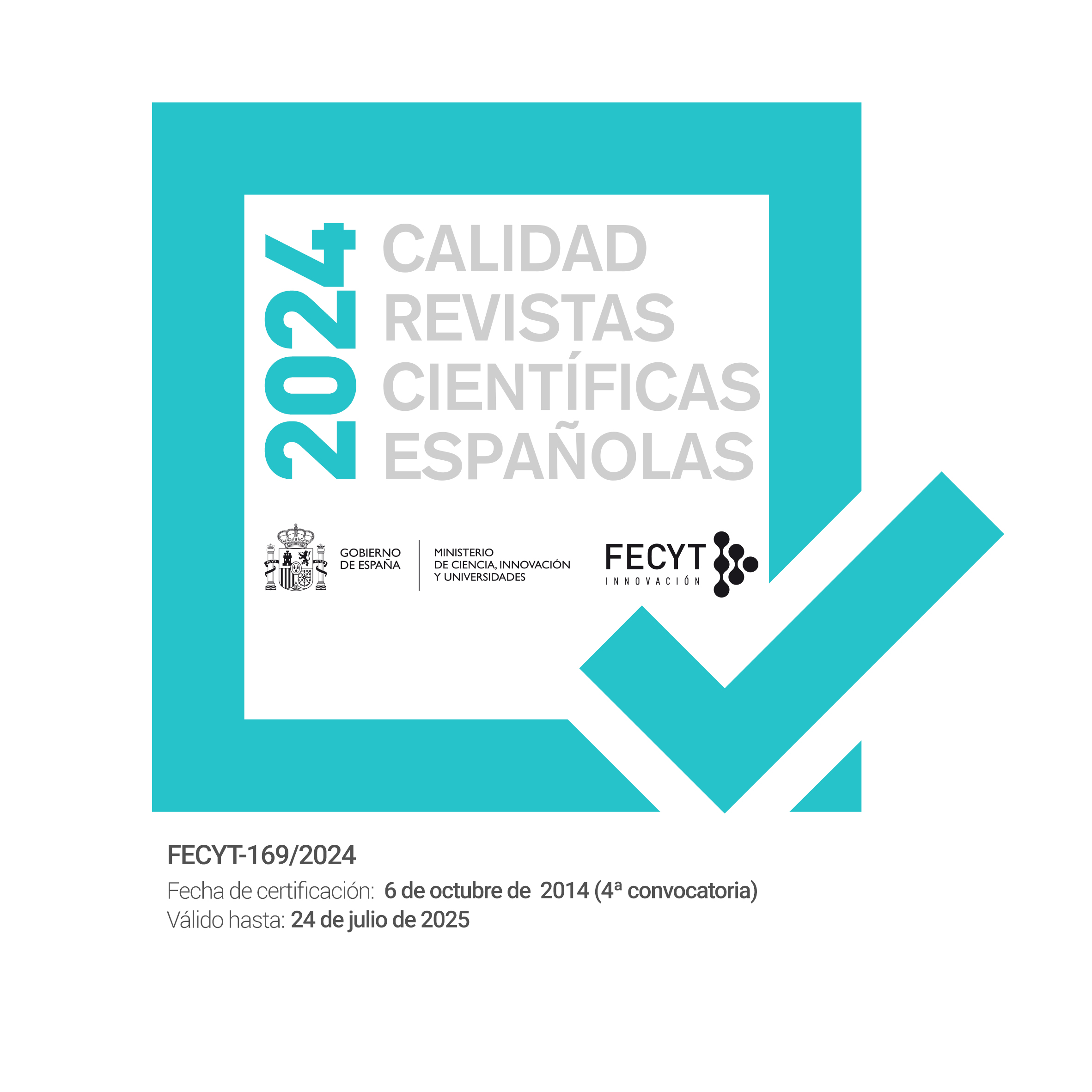CLIL and task-based learning: a hybrid teaching approach for teaching Spanish as a foreign language and literature in international schools in Spain
Keywords:
CLIL, TBL, International school, literature, Spanish 2/LAbstract
This article presents a didactic proposal based on task-based learning within the Content and Language Integrated Learning programme, which combines the work of the curricular content of the subject of Spanish Language and Literature, and the teaching of Spanish as a second language in a very specific context: a British school in Spain. Foreign students, through a sequence of microtasks, carry out a final task of a non-linguistic nature, but where they need to interact with their classmates, communicate with each other using Spanish. Throughout this methodological approach, learners acquire reflective, significant and quality knowledge -as promoted by the LOMLOE- of the contents of the subject. Collaborative work, sharing information, strategic planning, mastering not only contents for communication but also communicative processes allow preparing young people for the future, for lifelong learning.
Downloads
References
Alas “Clarín”, L. (2004). La Regenta I y II, ed. de Juan Oleza, Cátedra.
Attard, S., Walter, L., Theodorou, M. y Chrysanthou, K. (2014). The CLIL Guidebook, https://www.languages.dk/archive/clil4u/book/CLIL%20Book%20Original%20EN.pdf
Brumer, J. (1978). The role of dialogue in language acquisition. En Sinclair, J. y Levelt (eds.), The Child´s concept of language. Springer-Verlag.
Canale, M. y Swain, M. (1980). Theoretical Basis of Communicative Approaches to Second Language Teaching and Testing. Applied Linguistics, 1, 1-47.
Candlin, Ch. (1990). Hacia la enseñanza de lenguas basada en tareas. Comunicación, Lenguaje y Educación, vol. 7-8, 33-54.
Consejo de Europa (2001). Marco común europeo de referencia para las lenguas: aprendizaje, enseñanza, evaluación. Traducción al español por el Instituto Cervantes. MECD-Anaya. http://cvc.cervantes.es/ensenanza/biblioteca_ele/marco/
Consejo de Europa (2020). Marco común europeo de referencia para las lenguas: aprendizaje, enseñanza, evaluación. Volumen complementario. Servicio de Publicaciones del Consejo de Europa. Traducción al español por el Instituto Cervantes. https://rm.coe.int/marco-comun-europeo-de-referencia-para-las-lenguas-aprendizaje-ensenan/1680a52d53
Coyle, D. (2007). Content and language integrated learning: Towards a connected research agenda for CLIL pedagogies. International journal of bilingual education and bilingualism, 10(5), 543-562.
Ellis, R. (2003). Task-Bases Language Learning and Teaching. Oxford University Press.
Eurydice (2006). Content and Language Integrated Learning (CLIL) at School in Europe. Eurydice European Unit.
Gallardo del Puerto, F., & Martínez Adrián, M. (2013). ¿Es más efectivo el aprendizaje de la lengua extranjera en un contexto AICLE? Resultados de la investigación en España. Padres Y Maestros / Journal of Parents and Teachers, (349), 25–28. https://revistas.comillas.edu/index.php/padresymaestros/article/view/25-28
Griffin, K. (2005). Lingüística aplicada a la enseñanza del español como 2/L. Arco/Libros.
Gutiérrez Ordóñez, S. (2002). De pragmática y semántica. Arco/Libros.
Hymes, D. (1972). On communicative competence. En J. Pride & J. Holmes (Eds.) Sociolinguistics. Selected readings. Penguin (pp. 269-293).
Instituto Cervantes (2006). Plan curricular del Instituto Cervantes. Niveles de referencia para el español. Madrid: Instituto Cervantes- Biblioteca nueva.
http://cvc.cervantes.es/ensenanza/biblioteca_ele/plan_curricular/.
Jerez Naranjo, Y. y Garófalo Hernández, A. (2012), Aprendizaje basado en tareas aplicado a la enseñanza de las comunicaciones. RIELAC, Vol.XXXIII 3, 1-7.
Junta de Andalucía (2023), Las personas extranjeras en el mercado de trabajo andaluz. 2022. https://www.juntadeandalucia.es/servicioandaluzdeempleo/web/argos/web/es/ARGOS/Publicaciones/pdf/20230821_extranjeros_2022.pdf
Lorenzo, F., Casal, S., Moore, P., & Afonso, Y. M. (2009). Bilingüismo y Educación. Situación de la Red de Centros Bilingües en Andalucía. Fundación Centro de Estudios Andaluces.
Marsh, D. (1994). Bilingual Education & Content and Language Integrated Learning. International Association for Cross-cultural Communication, Language Teaching in the Member States of the European Union (Lingua) University of Sorbonne.
Megías Rosa, M. (2012). Formación, integración y colaboración: Palabras clave de CLIL, una charla con María Jesús Frigols. Encuentro: revista de investigación e innovación en la clase de idiomas, (21), 3-14.
Mehisto, P. Marsh, D. & Frigolos M.J. (2008). Uncovering CLIC: Content and Language Integrated Learning in Bilingual and Multilingual Education. Macmillan.
Nebeus, plataforma financiera (2024), https://blog.nebeus.com/trabajo-en-remoto-desde-espana-perspectivas-de-la-poblacion-britanica/
Nunan, D. (1989). Designing Task for the Communicative Classroom. Cambridge University Press.
Nunan, D. (2004). Task-Based Language Teaching. Cambridge University Press.
Richard J.C. y Rodgers, Th.S (20144ª). Current approaches and methods. En Richard J.C. y Rodgers, Th.S, Approaches and Methods in Language Teaching. Cambridge University Press (pp. 81-214).
Robles Ávila, S. (2005). Tareas formales en ELE: un acercamiento metalingüístico a los contenidos gramaticales. Las gramáticas y los diccionarios en la enseñanza del español como segunda lengua, deseo y realidad Actas del XV Congreso Internacional de ASELE, Sevilla, 2004. http://cvc.cervantes.es/ensenanza/biblioteca_ele/asele/pdf/15/15_0739.pdf
Robles Ávila, S. (2017). Deconstrucción del enfoque orientado a la acción, en AA.VV. La generosidad y la palabra. Estudios dedicados al profesor Jesús Sánchez Lobato (pp. 255-271). Sgel.
Robles Ávila, S. (2019). A vueltas con el enfoque orientado a la acción: leyendo las nuevas aportaciones desde el Volumen complementario del MCER (2017). Álabe (19). https://doi.org/10.15645/Alabe2019.19.10
Vygotski, L.S. (1978). Mind in Society: The Development of Higher Psychological Processes. Harvard University Press.
Wiliam, D. (2011). Embedded formative assessment. Solution Tree Press.
Wiliam, D. & Black, P. (1998). Inside the black box: Raising standards through classroom assessment. King’s College London. https://doi.org/10.3102/00346543068003373
Wolff, D. (2007). Bridging the gap between school and working life. En Marsh D. & Wolff, D. (eds.) Diverse Contexts-Converging goals: CLIC in Europe (pp. 15-25). Peter Lang.
Zanón, J. y Estaire, Sh. (1990). Diseño de unidades didácticas mediante tareas: Principios y Desarrollo. Comunicación, Lenguaje y Educación, vol. 7-8, pp.55-90.
Published
How to Cite
Issue
Section
License
Copyright (c) 2025 Sara Dell olmo Robles

This work is licensed under a Creative Commons Attribution 4.0 International License.















